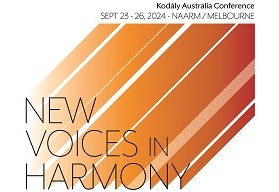Article By Tess Laird
The conductor’s compass has to point in many different directions!
NORTH!
The conductor is the top of the pinnacle! Meaning, you are the most important thing behind a successful choral programme (No pressure!). It’s the conductor’s job to fulfil the singers and allow them to shine, to remain passionate, humble and maintain integrity when pressured to choose inappropriate repertoire or perform in venues which are not suitable for choral singing. Therefore, it is absolutely imperative that you ensure you get lots of professional development, including singing lessons and being in a choral group yourself!
SOUTH!
The boring bits are the administrative tasks, however they are crucial to being prepared and continuing to develop your own and your singers’ skills.
Macro planning involves organizing the year’s calendar: marking performance dates, choosing appropriate repertoire for each event (make sure it’s available from the publishers early), organizing a good accompanist, and budgeting to allow for the purchase of music, accompanist fees, entry fees for festivals and eisteddfodau.
Some key things to consider when choosing repertoire for the year is to aim for a range of metres, moods, tempi and genres – creepy, funny, poignant, cute, Australian, folk, classical, etc. Make sure that you look carefully at the text, the range, the difficulty, the accompaniment, etc. It may that a piece is perfect except for the fact that it’s sacred, or that the range is too wide, or that the second part is too difficult for your singers to handle. In some cases, you may be able to approach the composer and ask to make simple changes that make the repertoire more approachable. It’s been my experience that most composers are happy to accommodate suggestions, and to even assist or re-arrange their own material.
Micro planning involves knowing the music really well before the first rehearsal! For this, some basic score analysis can help to avoid a lot of wasted time in rehearsals, and avoid the pitfalls that many choirs consistently fall into. Start by marking the general mechanical technique required, that is, which beats to cue/cut, and where to pause.
Sing the repertoire with the suggested metronome marking – often times it may be necessary to slow the markings to allow a choir to enunciate clearly or achieve accurate intonation. As you sing through, identify the potential vocal problems for the singers. High pitched entries, wide leaps, descending phrases, places for breathing, are all vocal issues that need careful consideration. Also mark the places where the singers may experience aural difficulties. For example, dissonant parts, rhythms which are tricky, etc. Identifying all of the above issues can be of great use when designing the warm ups for each rehearsal, so that potential problems are tackled before the actual repertoire is approached.
Musical considerations add the cherry on top to performances. Begin as you intend to continue! Identify and practice the particular dramatic/psychological effects contained within the text. Consider the tone quality, style and mood you want, analyse the text for syllabic accents, foreign or unknown words, humour, diphthongs, etc. Bringing all of this out as the singers meet the work initially can add infinite richness to the rehearsal and allow singers to connect with the audience much more effectively when it’s time to perform the work.
Other useful points that should be taken into account are places where the accompaniment supports or may confuse the singers. The acoustics of different performance venues will affect the tempo, articulation and dynamics that are appropriate for each piece.
In order to effectively plan for success, chart backwards from the performance date and mark what each rehearsal will focus on. The week before may include performance polishing issues such as walking on/off stage, spacing between singers, checking the singers are confident and know the music well even if you aren’t conducting as you listen from the back of the hall. I allow at least 2-3 weeks before the performance to cover these polishing techniques, and it’s great to rehearse in the venue itself if possible. Knowing how many rehearsals you have allows you to decide how much music will be learnt each week (i.e. map out the bar numbers, work out how long to spend on individual parts before putting parts together). Take into account that there will be interruptions due to illness, camps, excursions, testing, etc.
EAST!
Successful repertoire delivery depends on the composition and the execution of the rehearsal itself. Vocal warm ups should only take 5 minutes of your rehearsal. Fernando Malvar-Ruiz, director of the American Boys’ Choir, says there are many pitfalls in focusing too hard on warm-ups. Done badly, they merely foster bad habits, and sometimes the warm-up is treated as the goal, with ages spent on perfecting it!
There are many publications that contain excellent warm-ups, but James Jordan suggests covering a variety of activities to wake up the brain, wake up the body, practice correct breathing techniques, prepare healthy phonation, maintain resonant tone production on vowels, improve crisp diction, develop expressiveness (dynamics, articulation), and extend range.
While warm ups can be prepared in advance, after this, the conductor seems to spend most of the rehearsal in trouble shooting mode – that is, reacting to the sounds we hear produced by our choirs, and adjusting/modifying sound production to increase our aesthetic pleasure.
The following ideas may help to smooth over the usual problems that can happen during rehearsal on any number of occasions.
To develop consistent support, practice singing repertoire using a lip/tongue trill to develop even breath control, and using fricatives (jj, vv, th, zz) to engage support muscles. To achieve a unison blend, aim for maintaining consistent vowel colour. Adjusting the space inside the mouth and the lip position can alter timbral qualities very effectively. For a lighter blend, centre the articulators around the vowels of ah-eh-ee and spreading the mouth shape. For a darker blend, aim to reflect the ah-oh-oo colours, using a vertical mouth shape and covering vowels (not exposing teeth). Tone can also be directly influenced by how singers breathe – have them breathe through the vowel shape with a relaxed jaw, and make sure the breath is silent and de-constricted.
Mark O’Leary uses a game called “spot the faker” so that singers can listen to each other individually (or in parts or rows for inexperienced choirs) to check for consistent tone quality. Try starting the repertoire then alternating between individuals or sections as the song continues. It is easy to hear the weaker or less confident singers and to assess where work is needed.
There are many things you can do as a conductor to assist tone production. Work on gestures that focus or lighten the timbre, that immediately or gradually affect dynamics, that encourage legato or supported staccato singing, that connect to support muscles to assist wide leaps, air flow, relaxation of jaw, neck and tongue. Hand and arm position can also greatly affect the vocal tone produced by singers. Watch the YouTube videos featuring Rodney Eichenberger to illustrate the power of the simplest gestures.
The unique thing about singers as opposed to instrumentalists is that we use the text as well as musical notes to create our performances. Good diction requires flexibility of tongue, teeth, jaw and lips, soft and hard palate. In a choral sense, a sense of unison can be hindered by difficult text or the idiosyncrasies of pronunciation. Find hard words in the repertoire and speak them at faster speeds than would be required. Mark words like “fishing”, where it’s best to elongate the first vowel, and shorten the consonants. Allow students to ‘conduct’ with you to teach them how to avoid long “s” sounds or to place consonants together at the end of words.
Be aware of voiced and unvoiced consonants, avoid scooping, learn melodic lines by singing on vowels only, then add consonants later and check that they don’t hinder resonance. As a conductor you can experiment with various cues and releases that show the quality of consonants – emphatic, gentle, etc, which may enhance the choir’s delivery of the text.
Above all, avoid diphthongs – sustain the primary vowel colour of a word (eg: fire – sustain the initial vowel of ah and shorten the yer at the end; owl – sustain the ah and shorten the oo at the end; day – sustain the eh and shorten the ee at the end; where – shorten the oo at the start and sustain the eh; new – shorten the ee and sustain the oo at the end, etc).
Your facial expression can also have a remarkable effect on the performance which singers give. Teach them to mirror your expressions (with or without the music) in order to add a special zing to each performance. The eyes can sparkle, open wide, glare, blink, gaze, crinkle, etc. Ask them to imagine what each text feels like and to physically represent that in some way in their face. If you get the chance, allow the singers to watch videos of themselves.
WEST!
So you’ve organized yourself and your rehearsals are running like clockwork, but what about the singers? Choir organisation involves maximising each individual’s strengths and minimising their weaknesses. Julie Christiansen suggests placing strong singers toward the middle of a section, and your most intelligent singers in the lower and middle parts. Learn how to place voices within a section if intonation/blend is an issue. Put disorganized children next to disciplined ones, give children scores and teach them to read (using the data projector can be helpful here).
Plan your rehearsals the way you would a lesson – periods of concentration and relaxation are necessary. Consider allowing the choristers the chance to hear or see a recording of one of the pieces they are practicing. It can focus their efforts more effectively than your nagging!
To make performances more interesting, try occasionally mixing parts and using different positions – semicircles, one or two lines in an arc, a U shape, have the front row sitting, use antiphonal groups around the audience if the repertoire is suitable. etc. Consider how you enter the stage – from one direction, from 2 directions simultaneously, is there a curtain that can be employed? A good accompanist should be able to provide a “play off” where the group exits the stage, either singing a reprise or waving to the audience.
If there are no dynamics or vocal effects marked in the score, add them appropriately to create more interest. Your singers may even enjoy trying out their own ideas. Songs or hymns with many verses may be enhanced by using a soloist, and alternating unison or part singing. Consider using a melodic instrument to play the harmony or descant lines if inexperienced singers can’t manage. Add un-tuned percussion instruments for effect, such as a cymbal roll, wind chimes, tambour, rain stick, etc.
Choralography can make or break a performance. It should never detract from the vocal sound, but sparingly used can be very effective in keeping audience interest and helping the choir communicate the mood. Consider hand movements, looking in different directions, using shoulders, leaning forward, bending down, standing sideways or interacting with those beside you or behind you (hands on shoulders, high fives, back to back, etc.), and pointing at a particular person in the audience. Don’t forget claps, stamps and clicks, and give them a stylish gesture that is performed in sync. Props can be effective, for example, sun-glasses, hats, gloves, masks, eye patches; home-made instruments like kazoos, sand paper blocks; balloons, stuffed toys, party whistles, LED lights, etc… The possibilities are endless, but be frugal or everything simply becomes stale.
To conclude, successfully employing all of the jobs contained within the conductor’s compass is a monumental responsibility. None of us can truly master every facet of the task, however tackling as much as we can in the time given can make the difference between a successful and rich choral program and one which merely survives because our choristers love to sing for us.
Best wishes to all for a fulfilling and joyous experience directing your choirs and making beautiful music together!
“You have an instrument in your throat with a more beautiful tone than any violin in the world, if you will only use it. With this instrument you can come invigoratingly near to the great geniuses of music if there is only somebody to lead you on!” – Zoltan Kodȧly



